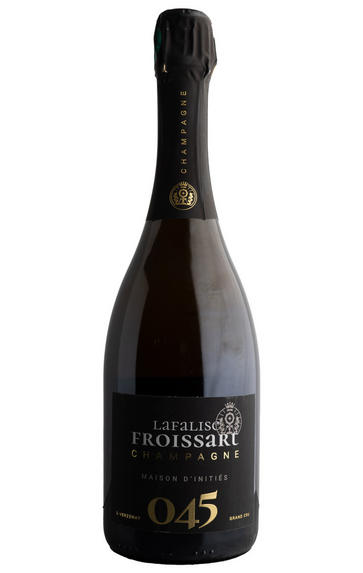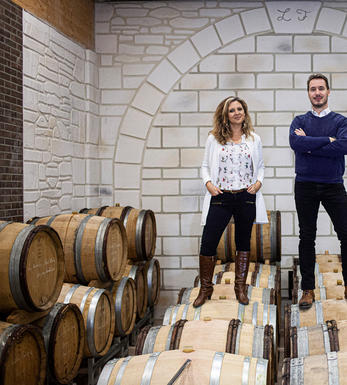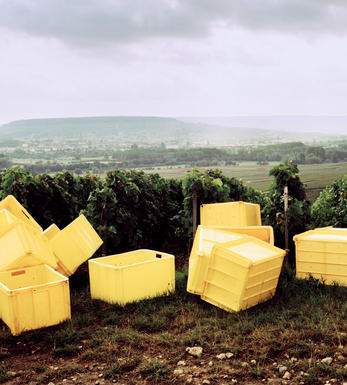
Champagne Lafalise Froissart, Cuvée 045, Grand Cru, Extra Brut

Critics reviews
The latest NV Champagne Cuvée 045 Extra Brut release is from the 2019 vintage and has three grams per litre dosage. The 045 is sourced from a parcel called Les Rochelles. Its nose is much fruitier, with black raspberry liqueur, strawberry, spice, and smoke. It is round, full-bodied, flush with red fruits, and rich with chalky texture and cracked pepper. This is another gastronomic wine to enjoy over the coming ten or more years.
Paul Froissart is the sixth generation of grape growers in his family and is based in the Grand Cru village of Verzenay. With a marketing background, he returned to the winery in 2014. Initially, he wanted to solely farm grapes and sell them to the houses, but in 2016, he made his first grapes press.
He farms five hectares of vine in Verzenay and a small parcel, Le Terre Rouge, in Dizy, and works with biodynamic principles where possible. Each of his cuvées is represented by a number instead of a name to represent the individual plot they are sourced from, and they are fermented and aged in barrel.
Drink 2022 - 2032
Jeb Dunnuck, JebDunnuck.com (November 2022)
About this WINE

Champagne Lafalise Froissart
Champagne Lafalise Froissart is found in the heart of the Verzenay Grand Cru vineyards, home to some of the greatest Pinot Noir in the Montagne de Reims. This family-run winery is now in the hands of the sixth generation, with Paul Froissart spearheading the operation and making the most of his intimate knowledge of their unique terroir.
Both organic and biodynamic certified, Lafalise Froissart prioritise the health of their soils and vineyards to great reward. They produce terroir-focused, elegant and precise wines that rub shoulders with the greatest names in the area.
The benefit of the low-intervention approach means that each parcel can express its own unique properties in the final wine. Lafalise Froissart's two cuvées, 045 and 276, have their own charming typicity and power. The 276 shows more minerality and freshness, while the 046 exemplifies the power and elegance of Pinot Noir. These are absolutely Champagnes for fans “in the know” – limited quantities of exceptional-quality wine that you can enjoy for years to come.

Champagne
Our wine buyers leave no stone unturned in their quest to find the best Champagnes, and Berry Bros. & Rudd takes particular pride in its eclectic range of artisan Champagnes that represent a real sense of terroir, original winemaking, labour-intensive viticulture (often organic/biodynamic) and the uncompromising excellence of the end product.
How Champagne is made
In 1668, in the village of Hautvillers, the monk turned cellar master, Dom Pérignon, is said to have discovered how to make sparkling wine; while the same technique is used all over the world today, the region of Champagne continues to make some of the finest.
So what makes wine sparkle? Adding a solution of sugar and yeast to a white wine starts another fermentation in the bottle which results in the bubbles. Once the yeasts have done their job, a sediment known as ‘lees’ collects on the side of the bottle; contact with this deposit during maturation gives the wine its characteristic flavours of freshly-baked bread, toast and biscuit. Once this sediment is isolated (remuage) and removed (dégorgement), the Champagne is topped up with a sugar solution to make it dry or sweet
The Champagne Wine Region
Champagne is the most northerly wine region in France and is situated north-east of Paris. There are three main vineyard areas: Côte des Blancs, Vallée de la Marne and Montagne de Reims.
Ripeness of the grapes is often a problem, which is one reason why a blend of grape varieties is usually used: the white Chardonnay to give fruit and elegance, and two reds – Pinot Noir (particularly to provide a ‘backbone’) and Pinot Meunier.
In Champagne there are around 15,000 growers and 290 Champagne houses. Traditionally, growers have sold their grapes to the Champagne houses which account for 70 percent of production and 90 percent of exports. Recently, increasing numbers of growers are making growers’ Champagnes themselves, using their own grapes.
The Champagne houses used to be organized into a Syndicat des Grandes Marques, which had 28 members, not all of them of equal quality. That has now been superseded by the Club des Grandes Marques, with 24 participants: Ayala, Billecart-Salmon, Bollinger, Canard- Duchêne, Deutz, Dom Pérignon, Heidsieck & Co. Monopole, Henriot, Krug, Lanson, Laurent-Perrier, Moët & Chandon, G.H. Mumm, Perrier Jouët, Joseph Perrier, Piper-Heidsieck, Pol Roger, Pommery, Ch. & A Prieur, Louis Roederer, Ruinart, Salon, Taittinger, Veuve Clicquot-Ponsardin.
Champagne Styles
Vintage Champagne
Made exclusively from grapes grown in a single year, this is produced only in the best years, and is released at about six years of age.
Non-Vintage Champagne
Most of the Champagne produced today is Non-Vintage, comprising the blended product of grapes from multiple vintages. Typically grapes from a single-year vintage will form the base of the blend, ranging from 15 percent to up to 40 percent.
Rosé Champagne
Typically light in colour, rosé Champagne is produced either by leaving the clear juice of black grapes to macerate on its skins for a brief time (known as saigneé), or by adding a small amount of Pinot Noir red wine to the sparkling wine cuvée. The saigneé method is more elaborate and costly, requiring highly-skilled winemaking, hence only a few houses still use it – among them Laurent Perrier and Louis Roederer.
Luxury (Prestige) Cuvée
Top of the range, this is vintage-dated. Famous examples include Louis Roederer's Cristal, Laurent-Perrier's Grand Siècle, Moët & Chandon's Dom Pérignon, Duval-Leroy's Cuvée Femme and Pol Roger's Cuvée Sir Winston Churchill.
Demi-Sec (Rich) Champagne
Demi-Sec or Rich is a medium-dry to medium-sweet style which occupies the other end of the spectrum from the standard dry "Brut" style. Brut Natural or Brut Zéro contains less than three grams of sugar per litre, Extra Brut has less than six grams of sugar per litre, and Brut less than 12 grams of sugar per litre.
Recently Disgorged Champagne
R.D. (Recently Disgorged) style was introduced for the first time by Madame Bollinger in 1961, on the 1952 Bollinger Grande Année vintage. Late disgorgement allows the Champagne to retain its freshness, vivacity and fruity expression, despite the ageing.
Blanc de Blancs Champagne
Blanc de Blancs denotes a Champagne made exclusively from Chardonnay grapes.
Blanc de Noirs Champagne
Blanc de Noir Champagnes are made exclusively from black grapes, Pinot Noir (typically) and Pinot Meunier grapes. Bollinger's prestige cuvée Vieilles Vignes Françaises is the lead example.

Pinot Noir
Pinot Noir is probably the most frustrating, and at times infuriating, wine grape in the world. However when it is successful, it can produce some of the most sublime wines known to man. This thin-skinned grape which grows in small, tight bunches performs well on well-drained, deepish limestone based subsoils as are found on Burgundy's Côte d'Or.
Pinot Noir is more susceptible than other varieties to over cropping - concentration and varietal character disappear rapidly if yields are excessive and yields as little as 25hl/ha are the norm for some climats of the Côte d`Or.
Because of the thinness of the skins, Pinot Noir wines are lighter in colour, body and tannins. However the best wines have grip, complexity and an intensity of fruit seldom found in wine from other grapes. Young Pinot Noir can smell almost sweet, redolent with freshly crushed raspberries, cherries and redcurrants. When mature, the best wines develop a sensuous, silky mouth feel with the fruit flavours deepening and gamey "sous-bois" nuances emerging.
The best examples are still found in Burgundy, although Pinot Noir`s key role in Champagne should not be forgotten. It is grown throughout the world with notable success in the Carneros and Russian River Valley districts of California, and the Martinborough and Central Otago regions of New Zealand.


Buying options
Add to wishlist
Description
Our latest allocation of this cuvée is based on the 2020 vintage (80% from the vintage, 20% from reserve wine), and is a wonderful example of how organic and biodynamic practises can create incredibly characterful champagnes. Pinot Noir dominant, this north-west exposure plot is complex – the winemaker Paul even referred to it as the ‘sulky, teenage’ vineyard, requiring constant management. The wine has a beautiful roundness, still elegant and fine but with a power that is irrepressible.
Highly aromatic, with red fruits bursting from the nose, the palate is full and round with a beautiful texture and a hint of pepper. There is also a strong minerality in the finish, with a tantalizing taste of chalk on the tip of your tongue. This is without doubt a perfect gastronomic wine, to enjoy and share with oysters or white meat dishes.
Drink now to 2028
Davy Żyw, Senior Buyer, Berry Bros. & Rudd (September 2023)
wine at a glance
Delivery and quality guarantee